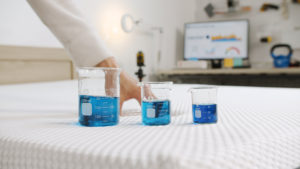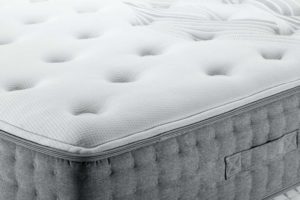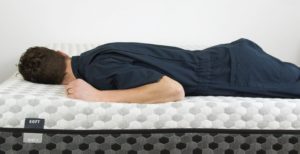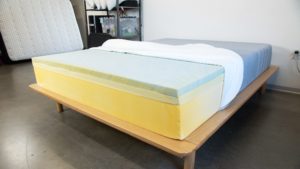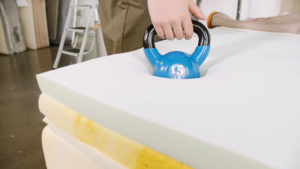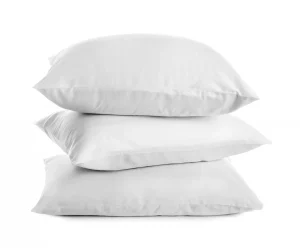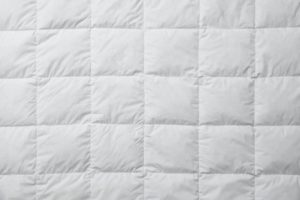Sex
Located in our Seattle HQ, the Test Lab evaluates every sleep product on the market. When researching and comparing mattress models, it’s important to consider every facet of a bed’s performance. While sex may seem like an afterthought, it represents a key performance category for couples and sexually active sleepers.
Most people agree the best beds for sex are those that are bouncy and easy to move on. However, the truth is that many factors contribute to a bed’s sex rating, including pressure relief, noise, temperature control, and edge support.
Our product testers analyze multiple facets of a mattress’ performance to determine its suitability for sex. We’ll explain how we derive our ratings for this crucial performance category, and examine what makes a mattress suitable for sex.
What Are Our Sex Ratings?
In terms of a mattress’ overall performance, sleep is always paramount. However, if you’re sexually active, you can’t ignore the impact your mattress has on your intimate moments.
Whereas features like pressure relief or temperature control lend themselves to objective testing measures, a mattress’ suitability for sex depends on a combination of factors. Personal preference can also influence the sex performance of any given mattress model, perhaps more so than other categories. However, in general, a bed that’s good for sex offers a balance between the following qualities:
- Bounce
- Contouring
- Noise
- Temperature Control
- Edge Support
If you’re shopping for a new mattress, you shouldn’t feel as though you must choose between a bed that performs well for sleep or for sex. Many of the qualities that make a mattress comfortable for sleeping are also found in the best mattresses for sex.
Who Should Care About a Bed’s Suitability for Sex?
Whether you’re single or in a relationship, the suitability of a mattress for sex is relevant if you plan to use your mattress for sexual activity.
If don’t think your new mattress will be used for intimate activities, feel free to ignore the sex rating.
Mattress Materials and Sex Ratings
While the best type of mattress for sex depends on your personal preference, some materials are typically better suited to sexual activity than others. Most couples prefer a bed that offers a balance between contouring and responsiveness. We’ll take a look at some commonly used materials and discuss how they stack up.
| Material | Description | Feel | Sex Performance |
|---|---|---|---|
| Memory Foam | Memory foam is a unique material with viscoelastic properties, meaning it changes shape in response to weight and pressure. This foam is generally reserved for a bed’s comfort section. | As it conforms closely to the sleeper, memory foam offers excellent pressure relief. Most sleepers sink into a memory foam mattress and experience a characteristic hug feeling. Memory foam also isolates most motion transfer, reducing sleep disturbances when sharing the bed. | Memory foam is virtually silent and helps cushion hips, knees, elbows, and other sensitive areas during sex. The major downside of memory foam is that it lacks bounce, can trap heat, and can hinder movement. |
| Polyfoam | Polyfoam, or polyurethane foam, is a synthetic foam that can vary widely in terms of performance. Due to its versatility, polyfoam can be used in all layers of a mattress. | The specific feel depends on the formulation, but polyfoam mattresses often provide cushioning with a quicker response to pressure than memory foam. | Polyfoam mattresses with moderate contouring and some level of resilience can perform relatively well for sex. All-foam mattresses tend to make little noise, but they can absorb and retain body heat. |
| Latex | Most latex mattresses use natural latex, made from the sap of rubber trees. Latex is often used in the comfort layers of a hybrid mattress, but you can also find all-latex mattresses. There are two common types of latex, the denser Dunlop latex and the lighter Talalay latex. | Latex has a consistent feel that provides moderate contouring, with less sinkage than memory foam. Latex also tends to be more resilient than all-foam beds. | Offering an excellent balance between cushioning and resilience, latex is often considered optimal for sex. Latex also tends to absorb less body heat than foam. |
| Microcoils | Microcoils consist of a thin layer of springy metal coils. This layer is only a few inches thick, and it can be incorporated into the comfort system or used as a transitional layer. Each coil is usually individually wrapped, so pressure on one coil has less effect on the surrounding coils. | Often seen in hybrid mattresses, microcoils are noticeably bouncy. They contour somewhat to the sleeper’s body, but the springs provide pushback that facilitates motion. | In addition to adding bounce, microcoils also contribute to temperature regulation and improve edge support, so that couples can use the whole surface of the bed without feelings of instability. Pocketed coils are less noisy than traditional innerspring coils. |
Sex Ratings by Mattress Type
The materials used in each layer of a mattress can tell you a great deal about how it may perform during sex. However, it’s also important to take into account its overall design and construction.
Nearly all mattresses on the market today are composed of at least two sections: a support core and a comfort layer, or sometimes a multi-layered comfort system. The support core provides a stable, durable base while the comfort layer provides cushioning and pressure relief.
Mattresses generally fall into one of five categories depending on their construction. Each mattress category tends to share some common benefits and drawbacks for sex, though individual models may vary based on their specific design.
All-Foam: All-foam mattresses use foam in both the support core and comfort layers. Because foam can take on different properties depending on how it is made, the suitability of any given all-foam bed for sex can vary substantially from model to model.
Mattresses made with foam are virtually silent. They often provide cushioning, so you’re less likely to develop painful pressure points regardless of position. However, foam mattresses are more likely to retain body heat and have poor edge support. If the comfort system is highly contouring, it can cause you to sink into the surface, which makes changing positions more difficult.
Latex: Mattresses that are made exclusively of latex offer many advantages for sex. Not only does latex provide some cushioning, but it also tends to be very responsive, which allows for easier movement. Additionally, latex beds are virtually silent and typically resist heat buildup.
Latex mattresses may have below-average edge support, and they don’t provide the best traction when compared to hybrid or foam mattresses.
Hybrid: Hybrid mattresses are typically made with a pocketed coil support core and cushioning materials such as polyfoam, memory foam, latex, or microcoils. Many hybrid mattresses feature individually wrapped coils that are designed to minimize noise.
The innerspring core improves airflow, strengthens the edges, and offers resilient bounce, enabling couples to easily generate force and switch positions during sex. Hybrid performance for sex also depends greatly on the comfort system. A hybrid with a moderately contouring polyfoam or latex comfort system may provide better performance than one made with deeply contouring memory foam, as the latter may restrict movement.
Innerspring: Whereas a hybrid mattress contains a coil support core combined with a comfort system, an innerspring mattress consists of just the coil support core. The mattress may have a very thin comfort layer, or none at all.
Innerspring mattresses have strong edge support and they are unrivaled for bounce, but the lack of cushioning may cause pressure points during sex. These models also tend to make more noise than other mattress types.
Airbed: Airbeds are constructed with pressure-relieving comfort layers over an air chamber support core, which may have adjustable firmness.
The suitability of an airbed for sex largely depends on the comfort layers. Models built with thick, plush comfort sections may inhibit movement and provide weak edge support. However, although air chambers aren’t exactly bouncy, airbeds with thinner comfort sections shouldn’t unduly impede movement.
How Do We Test a Bed’s Suitability for Sex?
Although mattress performance can be subjective, we do our best to cover every angle so you can make an informed purchase. This involves thousands of hours of product research and testing.
For most performance categories, such as temperature neutrality or motion isolation, we subject the mattress to a series of tests using testing equipment and our in-house testing team. As the suitability of a mattress for sex depends on a medley of factors, it’s difficult to measure using a straightforward test. Our ratings for sex are therefore compiled through careful consideration of the following traits:

Responsiveness: This metric refers to how quickly a material retakes its original shape after compressing in response to weight. We measure responsiveness by dropping a ball on a mattress from a set height and measuring the bounce. Materials with high responsiveness tend to feel bouncier and allow for easier movement, two features that are generally preferred for sex.


Contouring: Contouring measures the degree to which a mattress cradles the body. Mattresses that contour more closely tend to provide better pressure relief, but they may impede movement if they allow sleepers to sink in too far.
Moderate contouring tends to be best for sex because it provides traction and offers cushioning, while avoiding the sinking feeling that can make you feel stuck in the bed. Our testing team uses a pressure map to analyze pressure buildup in different positions among sleepers from different weight groups.
Noise: Some mattresses can be noisy when bearing weight, which may be a problem for couples who need to be discreet. Noise is most common with coil-based mattresses, though these may produce less noise if the coils are individually wrapped, or if the support core is muffled by a thick comfort system. As part of the testing process, our testers toss and turn, press firmly on the bed, and perform other lively movements that allow us to assess the amount of noise produced by the mattress.
Temperature Control: Temperature neutrality is a measure of how much body heat a mattress retains. Factors that affect temperature control include the materials, layer thickness, degree of contouring, and air circulation around the sleeper’s body. Mattresses with better temperature control can help you and your partner avoid overheating during sex. We use both human testers and a hot water bottle to measure heat buildup with each mattress we review.
Edge Support: This metric refers to how well a bed supports weight along the perimeter. Strong edge support reduces feelings of roll off around the edge of the bed. This provides a larger surface for sex and can make it easier to get into positions that involve the edge of the mattress.
To test for edge support, we measure sinkage while our testers sit, lie, and roll near the edge of the bed. The testers also get in and out of bed and bend over as if tying their shoes, which helps us see how the edges respond to movement.
Remember that a mattress’ suitability for sex is also highly subjective, and what works for one couple may not work for another. It’s therefore best to consider our ratings in the context of your own personal preferences.
It’s unusual for a mattress to excel in all performance categories. For example, mattresses with coils offer excellent bounce and ease of movement, but they may produce more noise. Mattresses with thick comfort layers may stifle movement, but they are quiet and they provide more traction. Depending on your unique needs and preferences, you may prefer to compromise on features that aren’t as important to you.
Learn more about the Test Lab at the link below.

Frequently Asked Questions About a Bed’s Suitability for Sex
Can I improve my bed’s suitability for sex?
In many cases, it’s possible to improve your bed’s suitability for sex without buying a new mattress. The first step is to establish why you don’t like the way your current mattress performs during sex. Some potential pitfalls include lack of bounce and difficulty moving, insufficient cushioning and traction, overheating, poor edge support, or excessive noise.
You can resolve many issues by tweaking your bedding or bedroom environment, or by purchasing a mattress topper to modify the feel of your bed’s comfort system. For example, if you suffer from overheating during sex, try using lighter bedding, setting your thermostat a few degrees cooler, or using a fan to circulate air near your bed. If your mattress is too firm or too highly contouring, consider using a mattress topper to change the firmness.
Issues with noise and instability may improve somewhat if you set the mattress on a sturdy foundation. Edge support is harder to fix, but you can try rotating your mattress from head to foot to reach areas of the bed that have not been subjected to as much wear and tear.As you make adjustments to your mattress setup, remember that your bed also needs to be comfortable for sleeping. If you sleep with a partner, you may want to lend more weight to issues such as motion isolation and noise.
What type of mattress is best for sex?
Although it’s a subjective question, certain types of mattresses are more likely to be suitable for sex. Latex and hybrid mattresses typically offer a good balance between contouring, bounce, low noise, edge support, and temperature regulation.
However, this doesn’t mean that you have to buy a latex or hybrid mattress to have great sex. There’s no one-size-fits-all answer when it comes to the best bed for sex, and many all-foam mattresses offer features that work well for sexual activity.
How does mattress durability impact sex?
A mattress made with low-quality materials may not stand up as well to vigorous movement, and the edges may be susceptible to premature sagging. Over time, low-density foams may also break down and start to lose their pressure-relieving capabilities, and poorly made springs may start to produce extra squeaks and creaks. Selecting a high-quality mattress can help prolong the usable lifespan for both sleep and sex.




